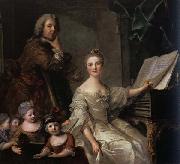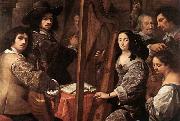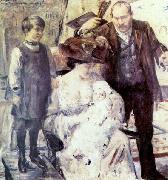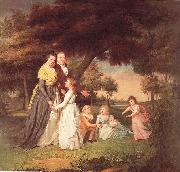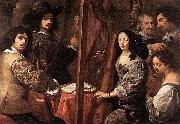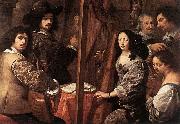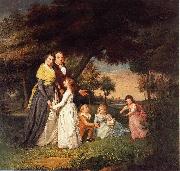Wholesale Oil Painting No Minimum |
|||||||||||
|
|
|||||||||||

|
|||||||||||
|
|
|
||||||||
Jjean-Marc nattierFrench Rococo Era Painter, 1685-1766 |
||||||||
|
|
||||||||
The Artist and his Family
The Artist and his Family Painting ID:: 26905 |
mk52
1730
Oil on canvas
142x163cm
Chateau de Versailles
mk52 1730 Oil on canvas 142x163cm Chateau de Versailles |
|||||||
|
|
||||||||
Carlo Francesco NuvoloneItalian Baroque Era Painter, 1609-1662 was an Italian painter of the Baroque period, active mainly in Lombardy. He was born in Milan to an Cremonese father and mannerist painter, Panfilo Nuvolone. After working with his father, he studied under Giovanni Battista Crespi (il Cerano) in the Accademia Ambrosiana in Milan. In that studio he would have encountered Daniele Crespi and Giulio Cesare Procaccini. Of particular interest is his depiction of himself as a painter surrounded by his family of artists |
||||||||
|
|
||||||||
|
|
The Artist and his Family
The Artist and his Family Painting ID:: 43678 |
Oil on canvas
transferred from panel,
126 x 180 cm Oil on canvas transferred from panel, 126 x 180 cm |
||||||
|
|
||||||||
Lovis CorinthGerman Painter, 1858-1925 German painter and writer. He grew up on his family's farm and tannery. As a child he showed interest in art, taking informal lessons in drawing from a local carpenter and caricaturing his primary school teachers. Corinth's father sent him to secondary school in the nearby city of K?nigsberg (now Kaliningrad), where he lived with his widowed aunt. A superstitious woman fond of story-telling, she possessed what Corinth later described as a coarse temperament and an unrestrained, 'demonic' humour. These qualities and his aunt's bohemian acquaintances, including fortune-tellers and soothsayers, fascinated the young Corinth, accustomed to his more reserved parents. |
||||||||
|
|
||||||||
|
|
The Artist and His Family
The Artist and His Family Painting ID:: 58449 |
The Artist and His Family, 1909, oil on canvas, Niedersächsisches Landesmuseum, Hanover. The Artist and His Family, 1909, oil on canvas, Niedersächsisches Landesmuseum, Hanover. |
||||||
|
|
||||||||
James Peale1749-1831 James Peale Galleries James Peale (1749 ?C May 24, 1831) was an American painter, best known for his miniature and still life paintings, and a younger brother of noted painter Charles Willson Peale. Peale was born in Chestertown, Maryland, the second child, after Charles, of Charles Peale (1709?C1750) and Margaret Triggs (1709?C1791). His father died when he was an infant, and the family moved to Annapolis. In 1762 he began to serve apprenticeships there, first in a saddlery and later in a cabinetmaking shop. After his brother Charles returned from London in 1769, where he had studied with Benjamin West, Peale served as his assistant and learned how to paint. Peale worked in his brother's studio until January 14, 1776, when he accepted a commission in the Continental Army as an ensign in William Smallwood's regiment. Within three months he was promoted to captain, and during the next three years fought in the battles of Long Island, White Plains, Trenton, Brandywine, Germantown, Princeton, and Monmouth. He resigned his army commission in 1779, and moved to Philadelphia to live with his brother. In 1782 he married, after which he established his own household and artistic career. (One notable later collaboration, however, was in 1788 to make floats for Philadelphia's Federal Procession in honor of the newly drafted United States Constitution.) At the outset of his career Peale painted portraits and still-life, and by the mid-1780s had established his reputation. At about this time, however, Charles turned over his own miniature portrait practice to him, and throughout the 1790s and early 1800s Peale devoted himself to miniature painting. Much of this work was watercolor on ivory. In 1795 Peale exhibited a still life of fruit along with nine miniatures and his family portrait at the Columbianum, a short-lived art academy in Philadelphia. Around 1810, as Peale's eyesight began to weaken, he gave up painting miniatures to turn to large portraits and still-life subjects that were greatly admired and widely exhibited in Philadelphia, Boston, and Baltimore. The total number of Peale's landscape paintings remains unknown, but he executed more than 200 watercolor miniatures on ivory, perhaps 100 still-life paintings, fewer than 70 oil portraits, and at least 8 history paintings. Peale died in Philadelphia on May 24, 1831. Three of his six children became accomplished painters: Anna Claypoole Peale (1798?C1871), a miniaturist and still-life painter; Margaretta Angelica Peale (1795?C1882), painter of trompe l??oeil subjects and tabletop fruit; and Sarah Miriam Peale (1800?C1885), a portraitist and still-life painter. |
||||||||
|
|
||||||||
|
|
The Artist and His Family
The Artist and His Family Painting ID:: 60030 |
The Artist and His Family
The Artist and His Family |
||||||
|
|
||||||||
Carlo Francesco NuvoloneItalian Baroque Era Painter, 1609-1662 was an Italian painter of the Baroque period, active mainly in Lombardy. He was born in Milan to an Cremonese father and mannerist painter, Panfilo Nuvolone. After working with his father, he studied under Giovanni Battista Crespi (il Cerano) in the Accademia Ambrosiana in Milan. In that studio he would have encountered Daniele Crespi and Giulio Cesare Procaccini. Of particular interest is his depiction of himself as a painter surrounded by his family of artists |
||||||||
|
|
||||||||
|
|
The Artist and his Family
The Artist and his Family Painting ID:: 86884 |
Date first half of 17th century
Medium Oil on canvas transferred from panel
Dimensions Height: 126 cm (49.6 in). Width: 180 cm (70.9 in).
cjr Date first half of 17th century Medium Oil on canvas transferred from panel Dimensions Height: 126 cm (49.6 in). Width: 180 cm (70.9 in). cjr |
||||||
|
|
||||||||
Carlo Francesco NuvoloneItalian Baroque Era Painter, 1609-1662 was an Italian painter of the Baroque period, active mainly in Lombardy. He was born in Milan to an Cremonese father and mannerist painter, Panfilo Nuvolone. After working with his father, he studied under Giovanni Battista Crespi (il Cerano) in the Accademia Ambrosiana in Milan. In that studio he would have encountered Daniele Crespi and Giulio Cesare Procaccini. Of particular interest is his depiction of himself as a painter surrounded by his family of artists |
||||||||
|
|
||||||||
|
|
The Artist and his Family
The Artist and his Family Painting ID:: 91638 |
first half of 17th century
Medium Oil on canvas transferred from panel
Dimensions Height: 126 cm (49.6 in). Width: 180 cm (70.9 in).
cyf first half of 17th century Medium Oil on canvas transferred from panel Dimensions Height: 126 cm (49.6 in). Width: 180 cm (70.9 in). cyf |
||||||
|
|
||||||||
James Peale1749-1831 James Peale Galleries James Peale (1749 ?C May 24, 1831) was an American painter, best known for his miniature and still life paintings, and a younger brother of noted painter Charles Willson Peale. Peale was born in Chestertown, Maryland, the second child, after Charles, of Charles Peale (1709?C1750) and Margaret Triggs (1709?C1791). His father died when he was an infant, and the family moved to Annapolis. In 1762 he began to serve apprenticeships there, first in a saddlery and later in a cabinetmaking shop. After his brother Charles returned from London in 1769, where he had studied with Benjamin West, Peale served as his assistant and learned how to paint. Peale worked in his brother's studio until January 14, 1776, when he accepted a commission in the Continental Army as an ensign in William Smallwood's regiment. Within three months he was promoted to captain, and during the next three years fought in the battles of Long Island, White Plains, Trenton, Brandywine, Germantown, Princeton, and Monmouth. He resigned his army commission in 1779, and moved to Philadelphia to live with his brother. In 1782 he married, after which he established his own household and artistic career. (One notable later collaboration, however, was in 1788 to make floats for Philadelphia's Federal Procession in honor of the newly drafted United States Constitution.) At the outset of his career Peale painted portraits and still-life, and by the mid-1780s had established his reputation. At about this time, however, Charles turned over his own miniature portrait practice to him, and throughout the 1790s and early 1800s Peale devoted himself to miniature painting. Much of this work was watercolor on ivory. In 1795 Peale exhibited a still life of fruit along with nine miniatures and his family portrait at the Columbianum, a short-lived art academy in Philadelphia. Around 1810, as Peale's eyesight began to weaken, he gave up painting miniatures to turn to large portraits and still-life subjects that were greatly admired and widely exhibited in Philadelphia, Boston, and Baltimore. The total number of Peale's landscape paintings remains unknown, but he executed more than 200 watercolor miniatures on ivory, perhaps 100 still-life paintings, fewer than 70 oil portraits, and at least 8 history paintings. Peale died in Philadelphia on May 24, 1831. Three of his six children became accomplished painters: Anna Claypoole Peale (1798?C1871), a miniaturist and still-life painter; Margaretta Angelica Peale (1795?C1882), painter of trompe l??oeil subjects and tabletop fruit; and Sarah Miriam Peale (1800?C1885), a portraitist and still-life painter. |
||||||||
|
|
||||||||
|
|
The Artist and His Family
The Artist and His Family Painting ID:: 96863 |
oil on canvas. Courtesy of Pennsylvania Academy of Fine Arts.
Date 1795(1795)
cyf oil on canvas. Courtesy of Pennsylvania Academy of Fine Arts. Date 1795(1795) cyf |
||||||
|
|
||||||||
|
James Peale 1749-1831 James Peale Galleries James Peale (1749 ?C May 24, 1831) was an American painter, best known for his miniature and still life paintings, and a younger brother of noted painter Charles Willson Peale. Peale was born in Chestertown, Maryland, the second child, after Charles, of Charles Peale (1709?C1750) and Margaret Triggs (1709?C1791). His father died when he was an infant, and the family moved to Annapolis. In 1762 he began to serve apprenticeships there, first in a saddlery and later in a cabinetmaking shop. After his brother Charles returned from London in 1769, where he had studied with Benjamin West, Peale served as his assistant and learned how to paint. Peale worked in his brother's studio until January 14, 1776, when he accepted a commission in the Continental Army as an ensign in William Smallwood's regiment. Within three months he was promoted to captain, and during the next three years fought in the battles of Long Island, White Plains, Trenton, Brandywine, Germantown, Princeton, and Monmouth. He resigned his army commission in 1779, and moved to Philadelphia to live with his brother. In 1782 he married, after which he established his own household and artistic career. (One notable later collaboration, however, was in 1788 to make floats for Philadelphia's Federal Procession in honor of the newly drafted United States Constitution.) At the outset of his career Peale painted portraits and still-life, and by the mid-1780s had established his reputation. At about this time, however, Charles turned over his own miniature portrait practice to him, and throughout the 1790s and early 1800s Peale devoted himself to miniature painting. Much of this work was watercolor on ivory. In 1795 Peale exhibited a still life of fruit along with nine miniatures and his family portrait at the Columbianum, a short-lived art academy in Philadelphia. Around 1810, as Peale's eyesight began to weaken, he gave up painting miniatures to turn to large portraits and still-life subjects that were greatly admired and widely exhibited in Philadelphia, Boston, and Baltimore. The total number of Peale's landscape paintings remains unknown, but he executed more than 200 watercolor miniatures on ivory, perhaps 100 still-life paintings, fewer than 70 oil portraits, and at least 8 history paintings. Peale died in Philadelphia on May 24, 1831. Three of his six children became accomplished painters: Anna Claypoole Peale (1798?C1871), a miniaturist and still-life painter; Margaretta Angelica Peale (1795?C1882), painter of trompe l??oeil subjects and tabletop fruit; and Sarah Miriam Peale (1800?C1885), a portraitist and still-life painter. The Artist and His Family oil on canvas. Courtesy of Pennsylvania Academy of Fine Arts. Date 1795(1795) cyf |
||||||||
|
|
||||||||
|
Prev Next
|
||||||||
|
|
||||||||
|
Related Paintings to James Peale :. |
||||||||
|
|
||||||||
|
CONTACT US |
